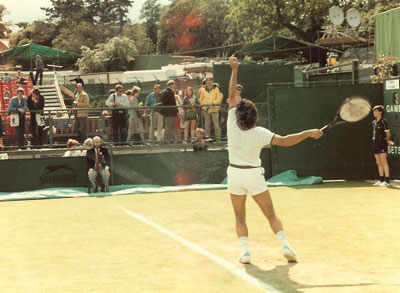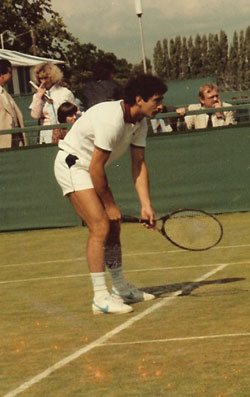Surgeon finds parallels between operating room and tennis court
Nicholas G.H. Mohtadi, MD, MSc, FRCSC, competed at the 1982 Wimbledon Championships.
Click Here to Manage Email Alerts
At one point, tennis was so important to sports medicine surgeon Nicholas G.H. Mohtadi, MD, MSc, FRCSC, that he delayed his internship to pursue a lifelong dream – playing at Wimbledon. The dream began when Mohtadi, influenced by his father, started playing tennis when he was 11.5 years old.
“My father had been a very good tennis player, so I had been around tennis courts most of my life,” he said.
Also like his father, Mohtadi was a multisport athlete, playing sports such as volleyball and basketball. Playing different sports ultimately helped him play tennis better, he said.
“By playing volleyball and basketball, I could jump higher than any other tennis player,” said Mohtadi, of the University of Calgary Sport Medicine Centre, Calgary, Alberta. “I was as fast as most of the tennis players from playing those other sports.”
|
Images: Mohtadi NGH |
Mohtadi said it is unfortunate that young athletes today are often forced to focus on one sport.
“I think focusing on one sport leads to possibly a higher success, but the downside is much worse. I believe in the concept of allowing people, kids in particular, to play every sport because it benefits you in the sport you ultimately choose,” he said.
Relaxed tennis training
This philosophy was borne out in Mohtadi’s relaxed tennis training. In the early years of his training, he played 3 months of the year because there were no indoor courts in Calgary at that time. Mohtadi played throughout his childhood and high school years. He quit tennis to play volleyball at the University of Calgary; however, he returned to tennis the second semester of his freshman year.
“I got lucky,” Mohtadi said. “I got a scholarship in the middle of the year that somebody else had turned down. I went to Oklahoma City University in January 1976 on a tennis scholarship.” He remained there for 3 years, except for a brief European stint in his second year.
When he faced the rigors of the first year of medical school, Mohtadi quit tennis again.
“But in my second year of medical school, I started playing a few tournaments again and did very well,” he said. “In my third year of medical school, I started organizing my schedule around my tennis tournaments.”
|
|
After graduating from medical school, Mohtadi took a year off to play tennis full time and to focus on achieving one of his dreams – playing at Wimbledon.
At the age of 25, he qualified for doubles at the famous grass tournament. Mohtadi’s regular doubles partner did not attend, so he played there in 1982 with Terry Bennett from Arizona whom he met on the circuit.
“Well, it turns out for the qualification for Wimbledon, we played three rounds and we won all three,” he said. “We beat the top-seeded team in the round and qualified.”
Dream come true
Stepping onto the grass at Wimbledon was both a thrill and a dream come true, Mohtadi said.
“My claim to fame is that I made it to the second week of Wimbledon, something that most people don’t do,” Mohtadi said. “That’s because it rained every day the first week.”
Unfortunately, Mohtadi and Bennett lost their match in the main draw.
“We really should’ve won that match, but we didn’t.”
Mohtadi quit the sport again after that match to start his internship.
“I was late getting to my internship,” he said. “Nobody was too happy about that.”
Tennis has influenced many aspects of Mohtadi’s life, including his choice of orthopedic specialty — sports medicine and arthroscopy.
“I was playing tennis with my mother, and she wrecked her knee as a result of me playing with her,” he said. “She had an operation on her knee, and I guess I felt guilty. That was my introduction to orthopedic surgery.”
Parallels between tennis court, OR
There are parallels between sports and surgery. “I look at the operating room as something similar to the tennis court,” Mohtadi said. “As an individual sport, you’re in charge on the tennis court, and as a surgeon, you’re sort of in charge in the operating room.”
Tennis and surgery require a great deal of intensity, he said. Additionally, both tennis and surgery bring out Mohtadi’s competitive nature.
“There’s a certain level of competition as a surgeon,” he said. “The way I look at it is, I’m competing against myself to do the best possible job. On the tennis court, you’re competing against someone else, which is a different scenario, but the idea of achieving excellence is one and the same.”
Mohtadi no longer plays tennis. Nowadays, he prefers fly-fishing and golfing.
“I can’t play the way I used to, and I get hurt every time I try, so I gave it up.” – by Colleen Owens

- Nicholas G.H. Mohtadi, MD, MSc, FRCSC, can be reached at 403-220-5077; email: mohtadi@ucalgary.ca.
- Disclosure: Mohtadi has no relevant financial disclosures.


